
Arms Dealer

This 1-drop is disappointing, and its weakness could be a setback for some of the potential aggressive undead archetypes looking for a strong opening and aren’t Death Knight. Arms Dealer’s ability is not bad, but its 2-health means that it is very easy to remove. You can play it later in the game and summon undead minions on the same turn so you can buff them immediately, but that doesn’t make it a good turn 1 play.
If the intention is for Arms Dealer to not to be a snowballing 1-drop, then the neutral undead set lacks a strong, standalone turn 1 play that could complement the early game options of other classes.
Score: 1
Foul Egg

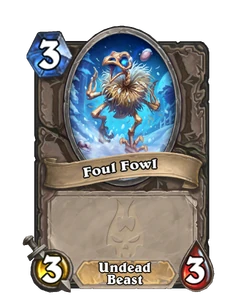
A 1-mana egg can be very impactful. This could be a strong 1-drop for classes that have early game buffs, can quickly activate the egg, and put pressure on the opponent. Ironically, despite its undead tag, Foul Egg could be a difficult card to play in the aggressive undead archetypes because they either don’t have enough tools to buff the egg, the tools available are weak and situational, or they lack space to accommodate these tools because of other deckbuilding limitations.
Foul Egg should be good because it’s an egg, not because it’s undead.
Score: 3
Classes: Druid, Paladin, Warrior
Bone Flinger

A 2 mana 2/3 that deals 2 damage is very good on turn 2, but as always with these cards, we tend to ask how often this card is going to be better than an undead River Crocolisk on turn 2. There are two potential answers. Either the deck has a lot of undead 1-drops that can die and trigger Flinger on curve. Alternatively, the deck has such a low curve with many other 2-drops, that Flinger doesn’t need to be played on 2. We can play other 2-drops that are not conditionally strong, use Flinger on turns 3-4 and still get good value from it.
Either way, the conclusion is that Flinger needs to go into undead decks that have a low curve and are very aggressive. There, it can find a home.
Score: 2
Classes: Death Knight, Druid, Shaman
Incorporeal Corporal

This is a very interesting card for aggressive decks, some with undead synergy. You can think of it as a delayed Mind Blast on a body. The opponent either invests resources to kill it or takes 5 damage to the face. The other thing that’s quite subtle about Corporal is that if your opponent ignores it, you can keep it on the board and not attack with it until you want to trigger a card that’s conditional on an undead minion dying. The ability to control an undead dying on your turn without needing to make a trade can be quite beneficial. It also has very nice synergies with specific class cards. Could be a staple.
Score: 3
Classes: Death Knight, Druid, Priest, Shaman
Infected Peasant

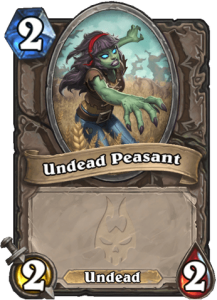
The undead tribe has a lot of conditional 2-drops that are not consistent on curve. Infected Peasant is a very consistent 2-drop on curve. It is essentially a Shielded Mini-bot, as it turns into a 2/2 after it takes damage the first time. The second body is an undead, so it can trigger undead synergies, but the most important thing about it is that it’s sticky. Very underrated piece that could help undead decks find more consistency in their early game development.
Score: 3
Classes: Death Knight, Druid, Shaman
Umbral Geist

This effect isn’t class limited. You can get a Shadow spell from any class. We don’t see why any deck would want this card though. The body is extremely weak and unsuitable for an aggressive deck, and the value is nothing special. There are better ways to generate value. Thief Rogue would never touch this.
Score: 1
Vrykul Necrolyte

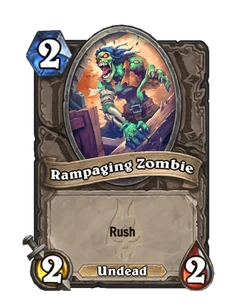
This card packs a lot of stats into its cost if it connects on another minion. A 2/2 and another 2/2 with rush summoned via deathrattle is well above the curve for 2 mana. You can buff a minion with Necrolyte, run it into something, and pop the 2/2 rush on the same turn. Both of its bodies, it’s important to note, are undead.
We think Necrolyte is going to be a popular card in aggressive undead decks. It works quite well with the Death Knight hero power on turn 4. It synergizes with Scourge Troll in Shaman. It’s perfect.
Score: 3
Classes: Death Knight, Druid, Shaman
Amber Whelp

This card was initially designed as a Paladin card, but Team 5 decided to move it into the neutral set, likely to fit another Paladin class card. This is a win for the class, which essentially got 11 class cards instead of 10. A 3/3 that deals 3 for 3 mana is very strong. Comparing it to Flanking Strike, it costs 1 less mana and can go face. Should be a staple in Dragon Paladin if the archetype pans out.
Score: 3
Classes: Paladin
Bloodied Knight

We’ve seen a fair share of these cards in the past: overstuffed early game minions with drawbacks. It seems that Flame Imp is the only one that has consistently been successful, likely because it’s a 1-drop. Once you get to turn 3-4, the cards drop off. This is likely because a stat disparity needs to come down very early to be impactful enough.
Score: 1
Brittleskin Zombie

A much worse neutral version of Shadowed Spirit, since the deathrattle can only proc on the opponent’s turn. We think this card has a bit of an anti-synergy with its own tribe. Undead decks want to curve out with strong stats every turn, and it’s very important for them to control the board. This is a relatively weaker body for a 3-drop, so we don’t see where it goes. Priest has the more powerful equivalent, and if we really need the burn, we run Corporal over this every time.
Score: 1
Drakkari Embalmer

A Spider Tank with a small upside if you have an undead minion in play. This is likely a bit too slow for aggressive undead decks, as we don’t expect them to run many cards that cost 3 or more without having significant impact on their game plan. Death Knight, Druid and Shaman all have better things to do on turn 3, and they are the classes you’d expect to utilize large undead shells. We haven’t found a combo utilization for this card that seems realistic.
Score: 1
Nerubian Vizier

This could become the most ubiquitous neutral of the set. A 3 mana 2/4 that discovers a spell is already better than Vulpera Scoundrel, but its ability to discount the spell by 2 mana puts it clearly above Venomous Scorpid in a deck that runs a healthy number of undead minions. The spell discount makes it likely to be included in aggressive decks because it’s not just a value card, but a card that can help you gain initiative.
Should be a popular inclusion in a variety of playstyles in Death Knight because of the ease of triggering the ability for the class.
Score: 4
Classes: Death Knight, Druid, Shaman
Scourge Rager

The best Rager ever made. Scourge Rager is a great resurrection target for Animate Dead and Bonecaller in Priest. It also has synergy with Switcheroo and activates undead synergy cards easily. This is the kind of card you can build an entire deck around. Are you ready for Rager Priest? You might be the one raging.
Score: 4
Classes: Priest
Silvermoon Arcanist

This is a very powerful Spell Damage enabler, being a rare +2 spell damage enabler that costs less than 4 mana. Though you can’t target face with it, you can still cast non-targeted spells that damage the enemy hero, such as Unleash Fel and Ricochet. Should have similar impact on the format as Talented Arcanist.
Score: 3
Classes: Demon Hunter, Hunter
Silvermoon Sentinel

The Manathirst ability here is too late. About half of all Hearthstone games are decided by turn 8, and a 3 mana 4/7 taunt at that stage is nothing to write home about.
Score: 1
Sunfury Clergy

That’s a lot of healing packed into a 3-drop, and the Manathirst activates on a reasonable turn 6. Can see this sneaking into a deck needing a stabilizer.
Score: 2
Classes: Priest, Mage, Warlock
Silvermoon Armorer

Another one of those “see, this is how Manathirst works” neutrals. You couldn’t even make it a 7/7 on turn 7?
Score: 1
Street Sweeper
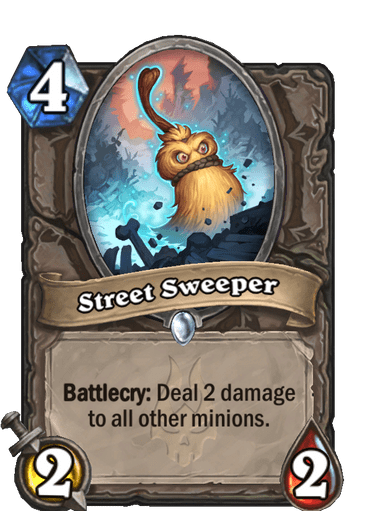
There have been plenty of AOE effects that cost 3 and deal 2 damage to all minions. Street Sweeper is a neutral version of these spells slapped on a 2/2 body. This gives us Spammy Arcanist vibes. Not in the sense of power, since Arcanist can potentially clear bigger boards, but rather in its role and the decks it goes into. It’s a way to plug in AOE into decks that don’t have the means to access them.
Score: 2
Classes: Druid, Mage
Shatterskin Gargoyle

This taunt seems awful. The damage can go face, but it’s random, likely to overkill, and we’re not sure why a slow deck would care about the effect.
Score: 1
Banshee

Remember how we mentioned earlier that undead neutral 1-drops kinda suck for undead decks? This is what we’re talking about. Banshee is another 1-drop that’s not really a 1-drop. If you play it on 1 and it dies, you just played a vanilla 2/1 for 1 mana. But this card isn’t even that good later in the game, since the opponent can just clear the other minions on the board before clearing the Banshee. It will occasionally connect, usually when you’re way ahead and the opponent cannot respond to your board. Not the hallmarks of a good 1-drop.
Score: 1
Coroner

This is a cheap and efficient tech card, giving decks a more versatile silence option than Royal Librarian. The silence coming online on turn 6 is around the time you want to start silencing most things. What’s nice is that its baseline form can still be a decent play in the early game. Not going to be a popular card, but something to occasionally tap into.
Score: 2
Classes: Just a tech card, bro
Infectious Ghoul

A neutral Greybough. The obvious big problem here is that Ghoul doesn’t have taunt, so it can’t stop your opponent from clearing your other minions before dealing with the Ghoul. It also has worse stats, making it particularly bad on an empty board. No thanks.
Score: 1
Tenacious San’layn

If this card sticks for a turn, it can deal 6 damage to the opponent’s hero while healing you for 6. But the moment you write “if this card sticks for a turn” in a card evaluation preview, you know there is only one way to score it.
Score: 1
Translocation Instructor

Another bad disruption card. Team 5 have been eager to print these recently. Instructor reminds us of Shadow Hunter Vol’jin, except that it pulls a minion from the deck. If we’re that desperate for expensive disruption effects, we might as well run a 6-mana Theotar.
Score: 1
Flesh Behemoth

The tutoring effect of Behemoth can help us add consistency to an undead package of big minions. It’s a big taunt with vanilla stats worth around 5-6 mana, so if it draws and summons a big threat, it’s theoretically ‘worth’ the cost. Still, this card costs 9 mana, and we would rather not spend mana on it at all. If that’s possible through some manipulation, Behemoth could see play.
Score: 2
Classes: Rogue, Shaman, Warlock
Crystal Broker

This card is awful on turn 3, still not very good on turn 5, and good on turn 10. Not the sign of a playable construction option. This is a card only Millhouse Manastorm would play.
Score: 1
Enchanter

Mo’arg Artificer that works with every source of damage and only affects enemies. This is quite an upgrade on its utility. You can do the normal Artificer combos with it, though Talented or Silvermoon Arcanist are better options if the spells deal a baseline damage of 1. You can play it and value trade with your minions on the board or use it in combination with a weapon. Enchanter has a decent chance of seeing play in some defensive deck, especially with lifesteal spells.
Score: 2
Classes: Death Knight, Warlock
Hawkstrider Rancher

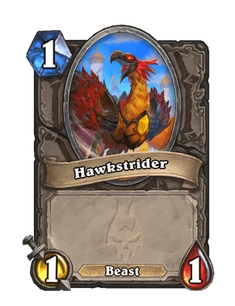
A massive card for board flooding decks, Rancher is a must kill target on turn 3 that can snowball games out of control. It doesn’t just buff minions but gives them a deathrattle that adds stickiness to the threats you develop, so it helps you leverage board buffs more easily.
At 5 health, it is very threatening on curve. If you’re ahead on board, which you usually are as an aggressive deck on turn 3, it is very difficult to clear from hand, and will usually force out multiple pieces. A passive opponent may not have the removal required to be able to deal with it at all, letting you run riot on turn 4. Looks particularly dangerous for Ramp Druid to face. Likely a staple card in swarming decks possessing a low curve.
Score: 4
Classes: Death Knight, Druid, Shaman
Plaguespreader

Yet another disruption. This one is a bit better than others, as it’s a simple standalone you can develop to the board, but the effect is tied to deathrattle, so it can be silenced, transformed, or just ignored until the opponents finds a more favorable situation that minimizes the likelihood of hitting a key target. Very, very niche.
Score: 1
Sanctum Spellbender

Hilarious counter to decks that rely on single target buffs. You drop this to the board and make a Bless Priest unable to play the game unless they have a Shard in hand. Could soak up some removal, but that’s a far less disruptive scenario since the removal card still gets to clear a minion you’ve developed.
Score: 2
Classes: Bless Priest griefer
Astalor Bloodsworn

This could be the Denathrius of March of the Lich King. Astalor is a single card win condition that requires very little synergy with the rest of the deck. At all stages of the game, it provides a useful benefit. On turn 4, it becomes a strong 2-cost minion, helping you clear a small minion from the board. On turn 7, it provides stabilization, and you can play the first two Astalors on that same turn. On turn 8, the final Astalor is okay, but on turn 10 it becomes a massive swing that can reasonably compete with a moderately infused Denathrius.
Astalor has synergy with Brann. First, it allows you to generate more Astalors to close out games with, though it doesn’t repeat the Manathirst abilities. Secondly, it does enable the final Astalor to deal 24 damage, a combo that can be accessed by any class with mana manipulation mechanics.
Astalor makes a lot of sense to run in Renathal decks. Those decks look for generic win conditions since they are less specialized at closing out games. This is a major reason why Renathal decks run Denathrius, and why Astalor is similarly a great fit. It doesn’t even require high minion density to utilize.
You’re going to see a lot of Astalor, whether as a standalone generic win condition, or as a combo piece. It is the generic powerhouse.
Score: 4
Classes: Death Knight, Druid, Mage, Paladin, Rogue, Shaman, Warrior
Bonelord Frostwhisper

The combo enabler extraordinaire of the set. Bonelord has a powerful deathrattle that makes the first card you play each turn cost no mana, with a significant drawback that gives you 3 turns to win the game, or else you die!
For combo decks, the drawback shouldn’t matter since you’re playing Bonelord with the intention of winning the game within a couple of turns thanks to the discount. The card opens opportunities for interactions that aren’t normally possible, potentially increasing the late game lethality of the format.
The card does present some issues. It can be ignored to delay the trigger or silenced/transform to negate it completely. It can also be stolen or disrupted in some way, since it’s quite an expensive piece that you might hold in your hand for an extended period. We think the card might work best in classes that are able to kill it on the same turn, or decks that still have a clear path to victory without it, but Bonelord allows them to accelerate it or cut some corners. Either way, expect it to be a very influential piece going forward. The effect is too powerful to ignore.
Score: 4
Classes: Death Knight, Mage, Paladin, Rogue, Shaman, Warrior.
Lor’themar Theron

A giga-Keleseth. Theron can be added into any minion-dense strategy and spike its late game to the point it becomes extremely hard to run it out of threats. The drawback is that it’s very slow, being a 7 mana 7/7 with no immediate impact on the board and likely useless in matchups in which games are decided by turn 8. The effect not working on minions in your hand is significant since you need to start drawing your buffed minions from your deck for Theron to have any impact on the game.
We see two uses for Theron. The first is as a tech card for decks with high minion density to perform better in control matchups. It’s a low hanging fruit. You can slap Theron in, and that late game becomes much more threatening. The second option is to leverage Theron with battlecry synergies that allow you to repeat the effect, such as Brilliant Macaw.
We don’t think it will be super common, but its ease of utilization is likely to make it a relevant player, especially in Renathal decks.
Score: 3
Classes: Death Knight, Hunter, Paladin, Shaman
Invincible

A giga-Bonemare. We’re noticing the callbacks to Knights of the Frozen Throne here. Invincible can’t choose its target but can potentially provide 15/15 stats in taunts over 3 charges in its lifespan. One comes from an immediate battlecry, the other two come deathrattles. That’s gargantuan pressure, making it something close to an 8 mana 25/21 in total stats.
Of course, the catch here is that for Invincible to trigger, you need another undead minion on the board. Your opponent can kill your other minions and deny your deathrattle buffs. Invincible is also very vulnerable to silence and mass removal effects such as Twisting Nether.
It’s a slow card that’s packed with value. Board-centric decks looking to pile more pressure on defensive decks may utilize it. It’s a softer Theron for these matchups, having a lower ceiling, but a card that can occasionally close out faster matchups if the board state is close to even. Another Renathal card.
Score: 3
Classes: Death Knight
The Sunwell

We already know what this card is capable of, and it isn’t too much. The random spell pool isn’t stellar. Sunwell does have some synergies with existing and new potential archetypes. It’s been a borderline competitive card for Thief Rogue, though with the kind of set the class got, we can’t expect it to make the cut. It’s also a possibility in Casino Mage, if that archetype ends up competitive, which is admittedly unlikely.
Mostly a fun card with niche competitive implications for some classes.
Score: 2
Classes: Mage, Priest, Rogue, Shaman
